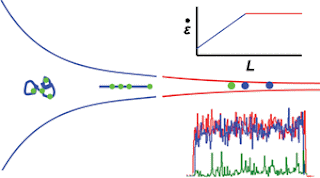The initial measured viscosities for the first 24 hours after inoculation were among the lowest reported to date. Following a low viscosity growth stage, sudden thickening was observed. During this stage, viscosity increased by over an order of magnitude in less than ten hours. The technique was also demonstrated as a promising platform for parallel experiments by subjecting multiple biofilm-laden microchannels to nutrient solutions containing NaCl in the range of 0 mM to 34 mM. Even in this narrow range of ionic strengths, preliminary data suggest a strong relationship between ionic strength and biofilm properties, such as average viscosity and time of onset of rapid thickening. The technique opens the way for a combinatorial approach to study the response of biofilm viscosity under well-controlled physical, chemical and biological growth conditions.
Friday, October 28, 2016
Why a microfluidic approach for continuous measurements of biofilm viscosity
The initial measured viscosities for the first 24 hours after inoculation were among the lowest reported to date. Following a low viscosity growth stage, sudden thickening was observed. During this stage, viscosity increased by over an order of magnitude in less than ten hours. The technique was also demonstrated as a promising platform for parallel experiments by subjecting multiple biofilm-laden microchannels to nutrient solutions containing NaCl in the range of 0 mM to 34 mM. Even in this narrow range of ionic strengths, preliminary data suggest a strong relationship between ionic strength and biofilm properties, such as average viscosity and time of onset of rapid thickening. The technique opens the way for a combinatorial approach to study the response of biofilm viscosity under well-controlled physical, chemical and biological growth conditions.
Labels:
Health Life,
Personal Insurance
